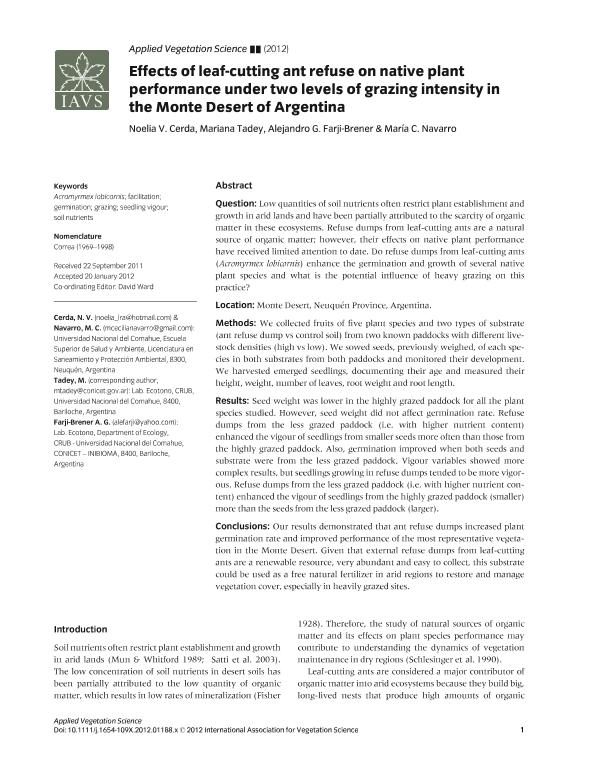Mostrar el registro sencillo del ítem
dc.contributor.author
Cerda, Noelia V.
dc.contributor.author
Tadey, Mariana

dc.contributor.author
Farji Brener, Alejandro Gustavo

dc.contributor.author
Navarro, Maria Carolina

dc.date.available
2017-01-10T18:30:35Z
dc.date.issued
2012-10
dc.identifier.citation
Cerda, Noelia V.; Tadey, Mariana; Farji Brener, Alejandro Gustavo; Navarro, Maria Carolina; Effects of leaf-cutting ant refuse on native plant performance under two levels of grazing intensity in the Monte Desert of Argentina; Wiley; Applied Vegetation Science; 15; 4; 10-2012; 479-487
dc.identifier.issn
1402-2001
dc.identifier.uri
http://hdl.handle.net/11336/11038
dc.description.abstract
Question: Low quantities of soil nutrients often restrict plant establishment and growth in arid lands and have been partially attributed to the scarcity of organic matter in these ecosystems. Refuse dumps from leaf-cutting ants are a natural source of organic matter; however, their effects on native plant performance have received limited attention to date. Do refuse dumps from leaf-cutting ants (Acromyrmex lobicornis) enhance the germination and growth of several native plant species and what is the potential influence of heavy grazing on this practice? Location: Monte Desert, Neuque´n Province, Argentina. Methods: We collected fruits of five plant species and two types of substrate (ant refuse dump vs control soil) from two known paddocks with different livestock densities (high vs low). We sowed seeds, previously weighed, of each species in both substrates from both paddocks and monitored their development. We harvested emerged seedlings, documenting their age and measured their height, weight, number of leaves, root weight and root length. Results: Seed weight was lower in the highly grazed paddock for all the plant species studied. However, seed weight did not affect germination rate. Refuse dumps from the less grazed paddock (i.e. with higher nutrient content) enhanced the vigour of seedlings from smaller seeds more often than those from the highly grazed paddock. Also, germination improved when both seeds and substrate were from the less grazed paddock. Vigour variables showed more complex results, but seedlings growing in refuse dumps tended to be more vigorous. Refuse dumps from the less grazed paddock (i.e. with higher nutrient content) enhanced the vigour of seedlings from the highly grazed paddock (smaller) more than the seeds from the less grazed paddock (larger). Conclusions: Our results demonstrated that ant refuse dumps increased plant germination rate and improved performance of the most representative vegetation in the Monte Desert. Given that external refuse dumps from leaf-cutting ants are a renewable resource, very abundant and easy to collect, this substrate could be used as a free natural fertilizer in arid regions to restore and manage vegetation cover, especially in heavily grazed sites.
dc.format
application/pdf
dc.language.iso
eng
dc.publisher
Wiley

dc.rights
info:eu-repo/semantics/openAccess
dc.rights.uri
https://creativecommons.org/licenses/by-nc-sa/2.5/ar/
dc.subject
Acromyrmex Lobicornis
dc.subject
Facilitation
dc.subject
Germination
dc.subject
Grazing
dc.subject
Seedlings Vigor
dc.subject
Soil Nutrients
dc.subject.classification
Ecología

dc.subject.classification
Ciencias Biológicas

dc.subject.classification
CIENCIAS NATURALES Y EXACTAS

dc.title
Effects of leaf-cutting ant refuse on native plant performance under two levels of grazing intensity in the Monte Desert of Argentina
dc.type
info:eu-repo/semantics/article
dc.type
info:ar-repo/semantics/artículo
dc.type
info:eu-repo/semantics/publishedVersion
dc.date.updated
2017-01-06T20:03:44Z
dc.journal.volume
15
dc.journal.number
4
dc.journal.pagination
479-487
dc.journal.pais
Reino Unido

dc.journal.ciudad
Londres
dc.description.fil
Fil: Cerda, Noelia V.. Universidad Nacional del Comahue; Argentina
dc.description.fil
Fil: Tadey, Mariana. Universidad Nacional del Comahue. Centro Regional Universitario Bariloche. Laboratorio de Ecotono; Argentina. Consejo Nacional de Investigaciones Científicas y Técnicas; Argentina
dc.description.fil
Fil: Farji Brener, Alejandro Gustavo. Consejo Nacional de Investigaciones Científicas y Técnicas. Centro Científico Tecnológico Patagonia Norte. Instituto de Investigación En Biodiversidad y Medioambiente; Argentina. Universidad Nacional del Comahue. Centro Regional Universitario Bariloche. Laboratorio de Ecotono; Argentina
dc.description.fil
Fil: Navarro, Maria Carolina. Universidad Nacional del Comahue; Argentina. Consejo Nacional de Investigaciones Científicas y Técnicas; Argentina
dc.journal.title
Applied Vegetation Science

dc.relation.alternativeid
info:eu-repo/semantics/altIdentifier/url/http://onlinelibrary.wiley.com/doi/10.1111/j.1654-109X.2012.01188.x/abstract;jsessionid=636183669E4436D6B958C72CD4F9B6E8.f02t03?systemMessage=Wiley+Online+Library+Journal+subscribe+and+renew+pages+for+some+journals+will+be+unavailable+on+Wednesday+11th+January+2017+from+06%3A00-12%3A00+GMT+%2F+01%3A00-07%3A00+EST+%2F+14%3A00-20%3A00+SGT+for+essential+maintenance.+Apologies+for+the+inconvenience
dc.relation.alternativeid
info:eu-repo/semantics/altIdentifier/doi/http://dx.doi.org/10.1111/j.1654-109X.2012.01188.x
Archivos asociados
